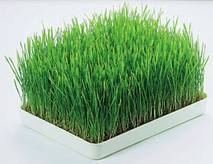Nope ó no kidding. From health-food stores to juice bars, wheatgrass has rapidly become one of the most widely used natural foods, and for very good reasons. Loaded with natural vitamins, chlorophyll, and enzymes that feed our cells and help rid them of toxins, wheatgrass is perfect for those seeking to create and maintain a healthy lifestyle.
Nutritionist Ann Wigmore explains that by adding wheatgrass to our diet, we can:

Improve the complexion and cleanse the body

Gain energy and strength

Increase the metabolism

More easily access the vitamins and minerals needed for optimum health

More quickly heal various ailments and illnesses
And I found even more benefits through some research: Apart from being rich in micro-nutrients, wheatgrass also contains protein, chlorophyll, calcium, Vitamin C and Lysine.
It has been known to help combat chronic fatigue syndrome.
Wheatgrass benefits the body in several ways, including cleansing the lymph system, building blood, restoring balance in the body, removing toxic metals from cells, nourishing the liver and kidneys and restoring vitality.
The amazing fact is that a single ounce of wheat grass juice has the nutritional equivalent of 2.2 pounds of fresh vegetables. Wheat grass is a living food. It is a complete protein with about 30 enzymes and is approximately 70% crude chlorophyll.

Iíve been intrigued by this wheatgrass business for a long time, so I finally bought a half-flat from my local health-food store, Good Earth. Each morning I use my kitchen shears to snip off Ĺ cup or more and toss it in my juicer with the rest of the fruit and greens Iím mixing up for the day.
I havenít noticed any appreciable change in taste of my green smoothie, even though wheatgrass has a strong grassy taste on its own. But what I have noticed is increased energy and what I think must be some internal cleansing going on, because my complexion is changing a smidge ó getting clearer.

I think Iím sold, so I got Ann Wigmoreís book,
The Wheatgrass Book, to learn how to do even more with this green. Itís been a wealth of information ó she goes into depth as to the benefits of wheatgrass to the body and what chlorophyll does for us, explains how to grow our own, and includes some basic recipes.
The only drawback I can see to wheatgrass is the need for a special juicer, if we want to drink it as a straight juice or use Annís recipes. I havenít gone that route since I have a Vita Mix. I just add it to the other greens I drink. Iím getting not just juice but the fiber as well ó smart juicing according to the experts.
But hereís the low-down on the wheatgrass juicer, in case this is the route you want to go: It acts slowly to extract the juice from each blade of wheat grass. Compared to other juicers, a wheatgrass juicer extracts the juices at slow speed, acting somewhat like a press. This is preferable because high-speed extraction might damage or destroy the enzymes. Most juicers have an RPM of 1000 or more, whereas wheatgrass machines usually run at 80-120 RPM. (Oops, MY juicer has the huge RPMs, so maybe Iíll look closer at the idea of getting a wheatgrass juicer after all!)

There are different types of wheatgrass machines available today. These are manual juicers, multi-purpose electric juicers, heavy-duty/commercial electric juicers, etc. The Weston Super Juicer, Commercial Grade Wheat Grass Juicer, 08-5000 (for about $800) is the model preferred by juice shops ó too pricey for this girl.
But Lexan and Miracle have wheatgrass juicers for between $175 and $189 ó thatís OK ó I can save up for that amount. But there is the hand-crank type by Healthy Juicer for around $45, and that is the route Iíd go if I wasnít working outside the home ó if I only had more time.
In case youíd like to try eating a little wheatgrass yourself, here are a couple of Annís recipes. If you donít have a wheatgrass juicer you might get some pre-prepared at your health-food store and try this out:
Wheatgrass Hopper
1 Ĺ oz wheatgrass juice
6 oz pineapple juice (about ľ of a fresh pineapple)
2 ice cubes
3 leaves fresh mint
Blend ingredients together at high speed for thirty seconds and serve.
 Download this recipe.
Wheatgrass Apple Cocktail
Download this recipe.
Wheatgrass Apple Cocktail
1 Ĺ oz wheatgrass juice
6 oz fresh apple juice (equal to 2 medium apples)
Pour wheatgrass juice and apple juice in a glass, stir and serve.
Contribute to the Cook'n Club!
DVO would love to publish your article, prose, photography and art as well as your cooking, kitchen and nutrition tips, tricks and secrets. Visit the Newsletter Submission / Win Win for All section in our Forum for more information and details.



